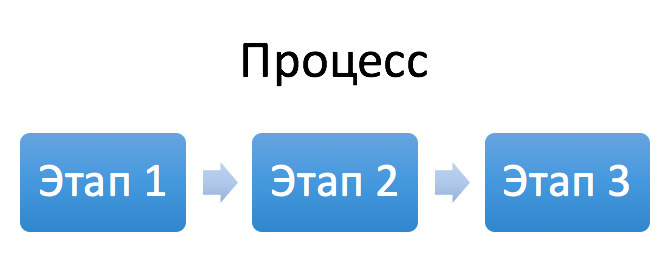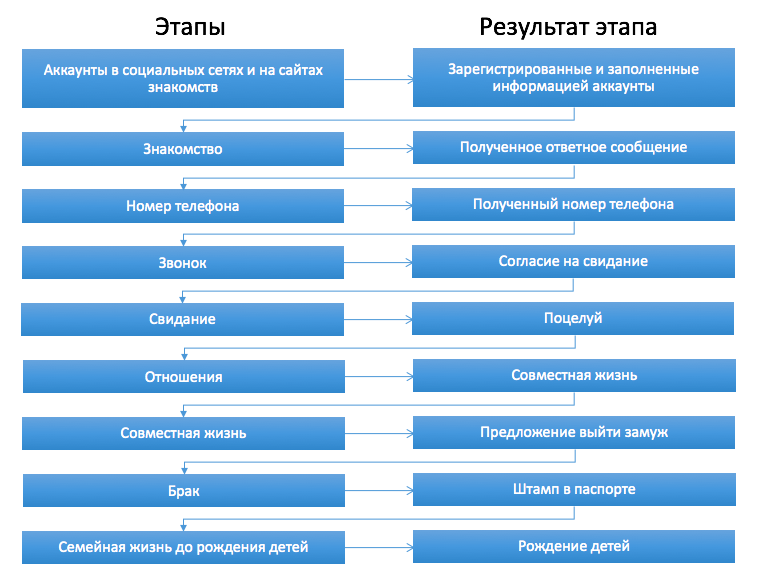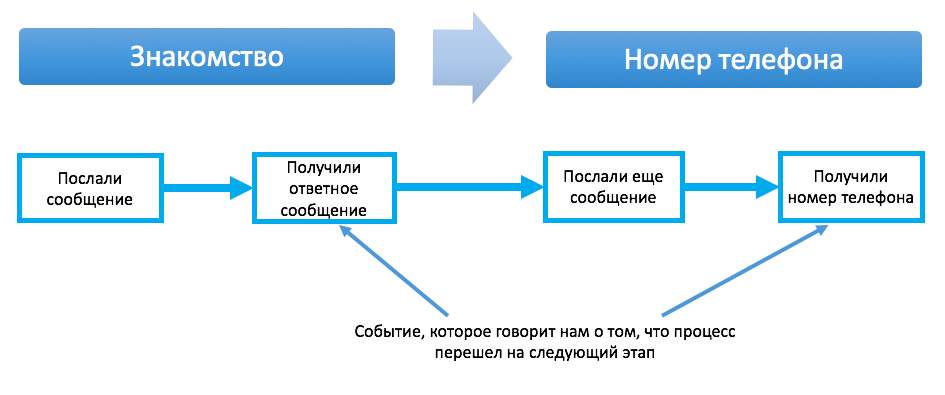Business automation (business processes) in simple words
How much time do your salespeople spend on things that are not related to sales, on everything except the call itself?
How much do you lose money until they sell?
How much time does it take for the rest of the employees to do what is not related to the result that you expect from them?
How much do you pay them for it?
I'm not going to consider why business automation is needed. Machines won manual labor back in the 19th century, and now any business owner knows why automation is needed better than many.
We will take time to another.
What is business process automation and how does it work.
To understand this, let's just break the business process automation apart.
')
So, the business process.
What is a business is clear to all.
But look at the process more closely.
What is the peculiarity of any process?
He has a beginning and an end.
And he has stages. Any process can be divided into stages. Even if you just decided to read this article, first you need to open it, and then read. This is already two stages. Therefore, any process consists of stages.

It is the presence of stages (steps, points) that enables us to automate the process. How?
You can give a very simple example.
As soon as the business owner knows some area in the business so well that he can describe what it needs to be done point by point in order to get results, he can hire employees and transfer this area to them.
We can say that for himself he automated the work.
He no longer participates in it, or participates to a minimum. And in the role of a system that automates everything, employees act.
Now he needs to go further and transfer all these processes to the computer. So that part of the routine work for the staff was done by the system, and they were engaged in bringing a concrete result.
But in order to understand how we can transfer the processes to the computer, let's look at the stages more specifically.
For example, we will analyze the process more interestingly.
The process of offspring.
Consider it from the man.

Imagine that you are a man, and you set out to get offspring.
You have no familiar women who suit you.
What is the sequence of stages?
The sequence is quite simple, if you do not go into it and not to excel.
Consider only that the offspring will be brought up within the family.

And now pay attention to the fact that a certain result corresponds to each stage.
And only with the onset of this result, the process can proceed to the next stage. Let's call it an event.
The event is what happened.

Also with each stage are related actions that need to be done.
For example:

We will also call them events. They happen.
There are many events connected with some stages, but in any case they are also connected with each other.
For example, if you sent a message, an event occurred - you sent a message.
In response to your message, the girl also sent you a message - this event.
The process, in our case, moved on to the next stage - “telephone number”.
Based on what happened, we understand how to proceed.
If a message arrives, we write the following message until we receive the phone.
Getting a phone is an event after which the process moves to the next stage.

Accordingly, what do we have?
1. Stages of the process.
2. The event, after which the process moves to the next stage.
3. Events that occur during the stage.
In fact, we have almost everything for automation.
The process consists of stages.
Each stage has a beginning and an end.
We know when the end of each stage (by the action after which the process moves to the next stage).
If we know the end of one stage, then we know when the beginning of the next stage occurs.
We also know the sequence of actions that occur during the stage.
Those. Our system always knows what stage the process is at and can therefore trigger certain events.
Actually here's your automation.
The only snag is that we have no artificial intelligence and the system itself cannot know about all the actions.
In the example above, the system would be able to send SMS itself, record calls, etc., but, for example, it would not be able to understand for itself whether the meeting was successful or not.
Thus, events can be divided into two types.
1. Events that occur in the system, or where it can fix them - in our case - is sending SMS, call. These are events that the system can record and even make itself.
If we talk about business, then this is any action that we can do from the system, or with the help of a certain technology - take a call, print, press something, form something inside the system, send a letter.
2. Events that occur outside the system - in our case, for example, a date.
With regard to business, this is any action that occurs outside the system, and the result that the system without your minimum participation can not fix. For example, a meeting, a meeting, an agreement about something.

In the first case, everything is simple. If something happened inside the system, then it can fix this action and do something for it.
In the second case, we just need the system to notify what happened.
For example, to complete the task set by the system, or choose from the options offered by the system.
Thus, everything turns out to be simple.
The whole process will occur automatically. All that is required for an employee is simply to perform normal actions, such as calls, printing, etc., and also to perform assigned tasks and respond when the system asks.
For example, I will describe part of the process.
You got a date.
The system sets you a task - “go on a date and kiss”
After the date, I log in to complete the task, press finish, and the system offers me options.

I point out to her what happened and then she acts herself.
REQUIRED - the system closes this process.
SUCCESSFULLY KISSED - the system moves the process to the “relationship” stage and sets the next task.
GOOD, BUT WITHOUT A KISS - the system sets the task of “making a date”.
NOT SUITABLE TO ME - the system closes this process.
How much do you lose money until they sell?
How much time does it take for the rest of the employees to do what is not related to the result that you expect from them?
How much do you pay them for it?
I'm not going to consider why business automation is needed. Machines won manual labor back in the 19th century, and now any business owner knows why automation is needed better than many.
We will take time to another.
What is business process automation and how does it work.
To understand this, let's just break the business process automation apart.
')
So, the business process.
What is a business is clear to all.
But look at the process more closely.
What is the peculiarity of any process?
He has a beginning and an end.
And he has stages. Any process can be divided into stages. Even if you just decided to read this article, first you need to open it, and then read. This is already two stages. Therefore, any process consists of stages.

It is the presence of stages (steps, points) that enables us to automate the process. How?
You can give a very simple example.
As soon as the business owner knows some area in the business so well that he can describe what it needs to be done point by point in order to get results, he can hire employees and transfer this area to them.
We can say that for himself he automated the work.
He no longer participates in it, or participates to a minimum. And in the role of a system that automates everything, employees act.
Now he needs to go further and transfer all these processes to the computer. So that part of the routine work for the staff was done by the system, and they were engaged in bringing a concrete result.
But in order to understand how we can transfer the processes to the computer, let's look at the stages more specifically.
For example, we will analyze the process more interestingly.
The process of offspring.
Consider it from the man.

Imagine that you are a man, and you set out to get offspring.
You have no familiar women who suit you.
What is the sequence of stages?
The sequence is quite simple, if you do not go into it and not to excel.
Consider only that the offspring will be brought up within the family.

And now pay attention to the fact that a certain result corresponds to each stage.
And only with the onset of this result, the process can proceed to the next stage. Let's call it an event.
The event is what happened.

Also with each stage are related actions that need to be done.
For example:

We will also call them events. They happen.
There are many events connected with some stages, but in any case they are also connected with each other.
For example, if you sent a message, an event occurred - you sent a message.
In response to your message, the girl also sent you a message - this event.
The process, in our case, moved on to the next stage - “telephone number”.
Based on what happened, we understand how to proceed.
If a message arrives, we write the following message until we receive the phone.
Getting a phone is an event after which the process moves to the next stage.

Accordingly, what do we have?
1. Stages of the process.
2. The event, after which the process moves to the next stage.
3. Events that occur during the stage.
In fact, we have almost everything for automation.
The process consists of stages.
Each stage has a beginning and an end.
We know when the end of each stage (by the action after which the process moves to the next stage).
If we know the end of one stage, then we know when the beginning of the next stage occurs.
We also know the sequence of actions that occur during the stage.
Those. Our system always knows what stage the process is at and can therefore trigger certain events.
Actually here's your automation.
The only snag is that we have no artificial intelligence and the system itself cannot know about all the actions.
In the example above, the system would be able to send SMS itself, record calls, etc., but, for example, it would not be able to understand for itself whether the meeting was successful or not.
Thus, events can be divided into two types.
1. Events that occur in the system, or where it can fix them - in our case - is sending SMS, call. These are events that the system can record and even make itself.
If we talk about business, then this is any action that we can do from the system, or with the help of a certain technology - take a call, print, press something, form something inside the system, send a letter.
2. Events that occur outside the system - in our case, for example, a date.
With regard to business, this is any action that occurs outside the system, and the result that the system without your minimum participation can not fix. For example, a meeting, a meeting, an agreement about something.

In the first case, everything is simple. If something happened inside the system, then it can fix this action and do something for it.
In the second case, we just need the system to notify what happened.
For example, to complete the task set by the system, or choose from the options offered by the system.
Thus, everything turns out to be simple.
The whole process will occur automatically. All that is required for an employee is simply to perform normal actions, such as calls, printing, etc., and also to perform assigned tasks and respond when the system asks.
For example, I will describe part of the process.
You got a date.
The system sets you a task - “go on a date and kiss”
After the date, I log in to complete the task, press finish, and the system offers me options.

I point out to her what happened and then she acts herself.
REQUIRED - the system closes this process.
SUCCESSFULLY KISSED - the system moves the process to the “relationship” stage and sets the next task.
GOOD, BUT WITHOUT A KISS - the system sets the task of “making a date”.
NOT SUITABLE TO ME - the system closes this process.
Source: https://habr.com/ru/post/343942/
All Articles